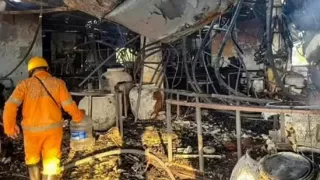The skies above Nashik witnessed history as the first Tejas Mk1A Light Combat Aircraft (LCA) successfully completed its maiden flight, marking a defining moment for India’s aerospace ambitions. The event, held in the presence of Defence Minister Rajnath Singh, saw the aircraft receive a grand water cannon salute upon landing, symbolizing India’s growing strength in indigenous defense technology. The ceremony also highlighted Hindustan Aeronautics Limited’s (HAL) remarkable efforts in setting up new facilities to accelerate production and innovation in military aviation.
Manufactured at HAL’s newly established third production line in Nashik, the Tejas Mk1A represents a major step in India’s “Atmanirbhar Bharat” (self-reliant India) vision. The aircraft was officially rolled out following the inauguration of both the Tejas Mk1A and HTT-40 (trainer aircraft) assembly centers, also in Nashik. This milestone underscores HAL’s determination to ramp up domestic production capabilities and meet the Indian Air Force’s growing demand for advanced, homegrown fighter jets.
The maiden flight marks the beginning of a new chapter for India’s defense industry. With the Tejas Mk1A now in the skies, HAL’s engineers and pilots have successfully demonstrated the country’s capability to design, manufacture, and test next-generation combat aircraft on home soil. The achievement not only enhances India’s defense preparedness but also boosts its status as a key player in the global aerospace sector.
HAL Expands Production to Meet Air Force Demand
Hindustan Aeronautics Limited has expanded its production capabilities by establishing the third Tejas Mk1A manufacturing line at its Aircraft Manufacturing Division in Nashik. The new line, which became operational in 2023, aims to significantly accelerate aircraft deliveries to the Indian Air Force. The facility can currently produce eight aircraft annually, with plans to scale up to ten per year as operations mature.
HAL officials revealed that the expansion was achieved using existing infrastructure such as hangars, manpower, and machinery, with an additional internal investment of approximately ₹500 crore. This financial boost was specifically directed toward meeting the technological requirements of the Tejas Mk1A aircraft. The facility will play a crucial role in enabling HAL to fulfill its order of 180 LCA Mk1A fighters for the Indian Air Force by 2032–33 — an ambitious target that reflects India’s growing emphasis on indigenous defense production.
According to HAL’s production roadmap, the Nashik line will complement existing facilities in Bengaluru and other regions, ensuring uninterrupted supply and testing cycles. The company’s new focus on digital manufacturing and modular assembly techniques is expected to reduce turnaround time, enhance precision, and maintain quality across all units. This marks a new phase of industrial efficiency for India’s defense sector, powered by domestic innovation.
Tejas Mk1A: The Next-Generation Indian Fighter
The Tejas Mk1A is not just a new aircraft; it’s a symbol of technological evolution in Indian aviation. It is a more advanced and multi-role variant of the original Tejas Mk1, designed to replace the aging MiG-21 fighters in the Indian Air Force’s fleet. The Mk1A features major upgrades such as state-of-the-art avionics, enhanced radar systems, air-to-air refueling capability, and a superior electronic warfare suite, making it capable of handling both air defense and ground-attack missions with improved efficiency.
One of the standout features of the Mk1A is its improved combat survivability. The aircraft integrates advanced self-protection systems that can detect, analyze, and respond to enemy radar and missile threats in real time. Its airframe incorporates lightweight composite materials to boost agility and reduce maintenance costs. Furthermore, the cockpit has been redesigned with a modern glass display, providing pilots with better situational awareness and reduced workload during high-intensity missions.
The Mk1A’s compatibility with a wide range of precision-guided munitions, beyond-visual-range missiles, and next-gen targeting pods enhances its operational flexibility. With these improvements, the Tejas Mk1A brings India closer to achieving complete self-reliance in the design, development, and deployment of modern fighter aircraft capable of competing with global peers.
Symbol of India’s Self-Reliance and Future Vision
Defence Minister Rajnath Singh, who inaugurated the facility, lauded HAL’s contribution to India’s defense modernization efforts. He emphasized that HAL’s model of sustainable development and industrial innovation should serve as a benchmark for other public and private sectors in India. Singh also highlighted the importance of creating environmentally responsible defense townships, praising HAL’s Nashik facility for setting a positive example in this regard.
In his address, Singh noted that the success of the Tejas Mk1A project represents not only technological advancement but also national pride. He stated that the development of indigenous fighter aircraft strengthens India’s security ecosystem while promoting local industry, employment, and engineering excellence. “In this era, HAL has set an example through this township. I believe that HAL’s model will now become a benchmark for other industries,” Singh remarked during his speech.
HAL’s success with the Tejas Mk1A demonstrates India’s steady movement toward defense self-sufficiency. The project brings together advanced engineering, modern manufacturing practices, and national ambition under one banner. As production ramps up, the Mk1A will not only safeguard India’s skies but also stand as a symbol of innovation, determination, and technological prowess on the global stage.
A New Era for Indian Aviation
The successful flight of the first Tejas Mk1A is more than just a technical milestone — it’s a defining moment in India’s journey to establish itself as a defense manufacturing powerhouse. With its indigenous design, advanced systems, and cost-effective maintenance, the Mk1A embodies the perfect blend of efficiency and innovation. The aircraft’s versatility ensures that it will serve effectively in multiple roles, from air superiority missions to precision strike operations.
HAL’s growing confidence in handling complex aircraft programs signals a shift in India’s industrial capabilities. The company’s collaboration with research agencies, private firms, and the Indian Air Force ensures that the Tejas program will continue to evolve, adapting to modern warfare demands. Future variants of the aircraft are expected to feature more AI-assisted avionics, improved stealth characteristics, and even integration with next-gen unmanned aerial systems.
With the Tejas Mk1A now in active production and flight testing, India’s defense sector is poised for a transformative decade. This achievement is not merely about building aircraft — it’s about building national confidence, creating global competitiveness, and securing the country’s future in aerospace innovation.
Also Read: Windows 11’s October 2025 Update Brings Powerful New AI























